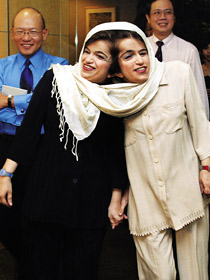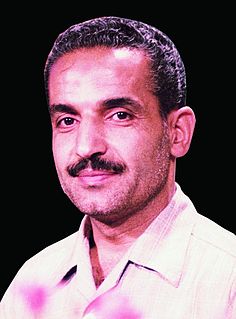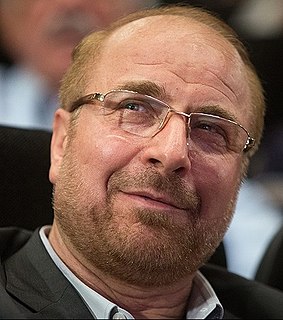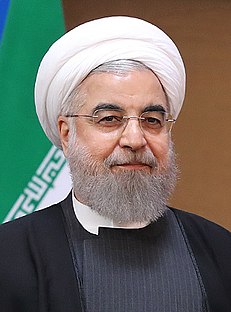This article does not cite any sources .(December 2009) (Learn how and when to remove this template message) |
| |||||
| Decades: | |||||
|---|---|---|---|---|---|
| See also: | Other events of 2003 Years in Iran | ||||
Events in the year 2003 in the Islamic Republic of Iran.
This article does not cite any sources .(December 2009) (Learn how and when to remove this template message) |
| |||||
| Decades: | |||||
|---|---|---|---|---|---|
| See also: | Other events of 2003 Years in Iran | ||||
Events in the year 2003 in the Islamic Republic of Iran.

The Supreme Leader of Iran, also referred to as Supreme Leader of the Islamic Revolution, but officially called the Supreme Leadership Authority, is the head of state as well as the ultimate political and religious authority of the Islamic Republic of Iran. The armed forces, judiciary, state television, and other key government organizations are subject to the Supreme Leader. The current longtime officeholder, Ali Khamenei, has been issuing decrees and making the final decisions on economy, environment, foreign policy, education, national planning, and everything else in Iran. Khamenei also makes the final decisions on the amount of transparency in elections, and has dismissed and reinstated presidential cabinet appointees. The Supreme Leader directly chooses the ministers of Defense, Intelligence and Foreign Affairs, as well as certain other ministers, such as the Science Minister. Iran's regional policy is directly controlled by the office of the Supreme Leader with the Ministry of Foreign Affairs' task limited to protocol and ceremonial occasions. All of Iran's ambassadors to Arab countries, for example, are chosen by the Quds Corps, which directly report to the Supreme Leader.

Sayyid Ali Hosseini Khamenei is a marja and the second and current Supreme Leader of Iran, in office since 1989. He was previously President of Iran from 1981 to 1989. Khamenei is the second-longest serving head of state in the Middle East, as well as the second-longest serving Iranian leader of the last century, after Shah Mohammed Reza Pahlavi.

The President of Iran is the head of government of the Islamic Republic of Iran. The President is the highest ranking official of Iran. The President carries out the decrees, and answers to the Supreme Leader of Iran, who functions as the country's head of state. Unlike the executive in other countries, the President of Iran does not have full control over anything, as these are ultimately under the control of the Supreme Leader. Chapter IX of the Constitution of the Islamic Republic of Iran sets forth the qualifications for presidential candidates. The procedures for presidential election and all other elections in Iran are outlined by the Supreme Leader. The President functions as the executive of the decrees and wishes of the Supreme Leader. These include signing treaties and other agreements with foreign countries and international organizations, with Supreme Leader's approval; administering national planning, budget, and state employment affairs, as decreed by the Supreme Leader. The President also appoints the ministers, subject to the approval of Parliament, and the Supreme Leader who can dismiss or reinstate any of the ministers at any time, regardless of the president or parliament's decision. The Supreme Leader Ali Khamenei directly chooses the ministries of Defense, Intelligence and Foreign Affairs, as well as certain other ministries, such as the Science Ministry. Iran’s regional policy is directly controlled by the office of the Supreme Leader with the Ministry of Foreign Affairs’ task limited to protocol and ceremonial occasions. All of Iran’s ambassadors to Arab countries, for example, are chosen by the Quds Corps, which directly reports to the Supreme Leader.
This section needs expansion. You can help by adding to it.(October 2010) |

The 2003 Bam earthquake struck the Kerman province of southeastern Iran at 01:56 UTC on December 26. The shock had a moment magnitude of 6.6 and a maximum Mercalli intensity of IX (Violent). The earthquake was particularly destructive in Bam, with the death toll amounting to at least 26,271 people and injuring up to 30,000. The effects of the earthquake were exacerbated by the use of mud brick as the standard construction medium; many of the area's structures did not comply with earthquake regulations set in 1989.

Iran, also called Persia and officially known as the Islamic Republic of Iran, is a country in Western Asia. With over 81 million inhabitants, Iran is the world's 18th most populous country. Comprising a land area of 1,648,195 km2 (636,372 sq mi), it is the second largest country in the Middle East and the 17th largest in the world. Iran is bordered to the northwest by Armenia and the Republic of Azerbaijan, to the north by the Caspian Sea, to the northeast by Turkmenistan, to the east by Afghanistan and Pakistan, to the south by the Persian Gulf and the Gulf of Oman, and to the west by Turkey and Iraq. The country's central location in Eurasia and Western Asia, and its proximity to the Strait of Hormuz, give it geostrategic importance. Tehran is the country's capital and largest city, as well as its leading economic and cultural center.
This section needs expansion. You can help by adding to it.(November 2010) |

Ladan and Laleh Bijani were Iranian conjoined twin sisters. They were joined at the head and died immediately after their complicated surgical separation. Coincidentally, the twins were born 100 years to the day of the deaths of Chang and Eng Bunker, also conjoined twins, famously known as the "original" Siamese twins.

Conjoined twins are identical twins joined in utero. An extremely rare phenomenon, the occurrence is estimated to range from 1 in 49,000 births to 1 in 189,000 births, with a somewhat higher incidence in Southwest Asia and Africa. Approximately half are stillborn, and an additional one-third die within 24 hours. Most live births are female, with a ratio of 3:1.
Mohammad Oraz, was an Iranian mountain climber. He was the second Iranian climber after Hooman Aprin to conquer Mount Everest, reaching the summit in 1998
| This year in Iran article is a stub. You can help Wikipedia by expanding it. |

Seyyed Mohammad Khatami served as the fifth President of Iran from 3 August 1997 to 3 August 2005. He also served as Iran's Minister of Culture from 1982 to 1992. He was a critic of former President Mahmoud Ahmadinejad's government.

Ali Shamkhani is an Iranian Rear Admiral Upper Half. He is the secretary of the Supreme National Security Council of Iran.

Mohammad-Ali Rajai was the second President of Iran from 2 to 30 August 1981 after serving as prime minister under Abolhassan Banisadr. He was also minister of foreign affairs from 11 March 1981 to 15 August 1981, while he was prime minister. He was assassinated in a bombing on 30 August 1981 along with prime minister Mohammad-Javad Bahonar.

The Islamic Republic of Iranian Broadcasting (IRIB), formerly called National Iranian Radio and Television until the Iranian revolution of 1979, is an Iranian media corporation which holds a monopoly of domestic radio and television services in Iran, and is also among the largest media organizations in the Asian and Pacific regions, and a regular member of Asia-Pacific Broadcasting Union. IRIB is independent of the Iranian government, but its head is appointed directly by the Supreme Leader, Ayatollah Ali Khamenei.

Hassan Ebrahim Habibi was an Iranian politician, lawyer, scholar and the first vice president from 1989 until 2001 under Presidents Akbar Hashemi Rafsanjani and Mohammad Khatami. He was also a member of the High Council of Cultural Revolution and head of Academy of Persian Language and Literature from 2004 until his death in 2013.

The Prime Minister of Iran was a political post in Iran that had existed during several different periods of time starting with the Qajar era until its most recent revival from 1979 to 1989 following the Iranian Revolution.

The Ministry of Foreign Affairs is an Iranian government ministry headed by the Minister of Foreign Affairs, who is a member of cabinet. The current Minister of Foreign Affairs is Mohammad Javad Zarif, who was approved by the Parliament on 15 August 2013 after being nominated by the President.

Mohammad Bagher Ghalibaf is an Iranian conservative politician and former military officer who held office as the Mayor of Tehran from 2005 to 2017. Ghalibaf was formerly Iran's Chief of police from 2000 to 2005 and commander of Revolutionary Guards' Air Force from 1997 to 2000.

The Executives of Construction of Iran Party is a reformist political party in Iran, founded by 16 members of the cabinet of the then President Akbar Hashemi Rafsanjani in 1996. The party is a member of Council for coordinating the Reforms Front.

Mohammad-Hossein Saffar-Harandi is an Iranian politician who was minister of culture and Islamic guidance of Iran from 21 August 2005 until 23 July 2009 when he resigned after opposing the appointment of Esfandiar Rahim Mashaei as vice president.

Mohammad Javad Zarif Khonsari is an Iranian career diplomat and academic. He is the current foreign minister of Iran since 2013. He has held various significant diplomatic and cabinet posts since the 1990s. Zarif is also a visiting professor at the School of International Relations and University of Tehran, teaching diplomacy and international organizations. He was the Permanent Representative of Iran to the United Nations from 2002 to 2007.
The following lists events that happened during 2005 in the Islamic Republic of Iran.

Mohammad Reza Pahlavi, also known as Mohammad Reza Shah, was the last Shah of Iran from 16 September 1941 until his overthrow by the Islamic Revolution on 11 February 1979. Mohammad Reza Shah took the title Shahanshah on 26 October 1967. He was the second and last monarch of the House of Pahlavi. Mohammad Reza Shah Pahlavi held several other titles, including that of Aryamehr and Bozorg Arteshtaran ("Commander-in-Chief"). His dream of what he referred to as a "Great Civilisation" in Iran led to a rapid industrial and military modernisation, as well as economic and social reforms.

Esfandiar Rahim Mashaei is an Iranian politician and former intelligence officer. As a senior Cabinet member in the administration of President Mahmoud Ahmadinejad, he served as Chief of Staff from 2009 to 2013, and as the First Vice President of Iran for one week in 2009 until his resignation was ordered by Supreme Leader Ayatollah Ali Khamenei.

The Cabinet of Iran is a formal body composed of government officials, ministers, chosen and led by a President. Its composition must be approved by a vote in the Parliament. According to the Constitution of the Islamic Republic of Iran, the President may dismiss members of the cabinet, but must do so in writing, and new appointees must again be approved by the Parliament. The cabinet meets weekly on Saturdays in Tehran. There may be additional meetings if circumstances require it. The president chairs the meetings.
Events in the year 2010 in the Islamic Republic of Iran.

Hassan Rouhani is an Iranian politician serving as the current and seventh President of Iran since 3 August 2013. He was also a lawyer, academic, former diplomat and Islamic cleric. He has been a member of Iran's Assembly of Experts since 1999, member of the Expediency Council since 1991, and a member of the Supreme National Security Council since 1989. Rouhani was deputy speaker of the fourth and fifth terms of the Parliament of Iran (Majlis) and Secretary of the Supreme National Security Council from 1989 to 2005. In the latter capacity, he was the country's top negotiator with the EU three, UK, France, and Germany, on nuclear technology in Iran, and has also served as a Shi'ite ijtihadi cleric, and economic trade negotiator. He has expressed official support for upholding the rights of ethnic and religious minorities. In 2013, he appointed former industries minister Eshaq Jahangiri as his first vice-president.
Events from the year 1997 in Iran.
The following lists events that happened during 1981 in Iran.

Mohammad Farhadi is an Iranian physician, politician and former Minister of Science, a position he held from 26 November 2014 until 20 August 2017. He was previously President of the Red Crescent Society of the Islamic Republic of Iran from 2013 to 2014, Minister of Health from 1997 to 2001 in the first cabinet of President Mohammad Khatami, Minister of Culture and Higher Education from 1985 to 1989 in the second cabinet of Mir-Hossein Mousavi and President of the University of Tehran in 1985. He was also Vice President of the Red Crescent Society of the Islamic Republic of Iran in the first years of 1980's.